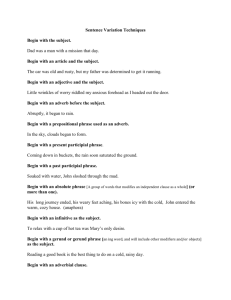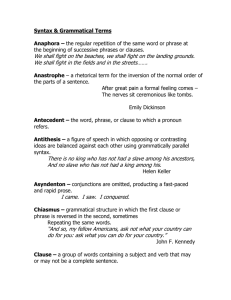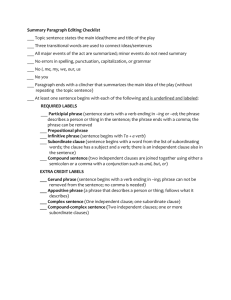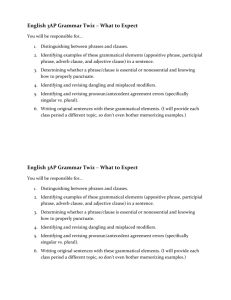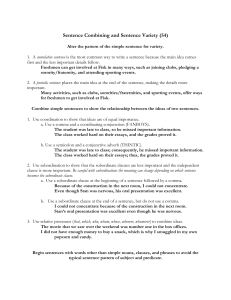M3L2N2 sentence variation transcript
advertisement
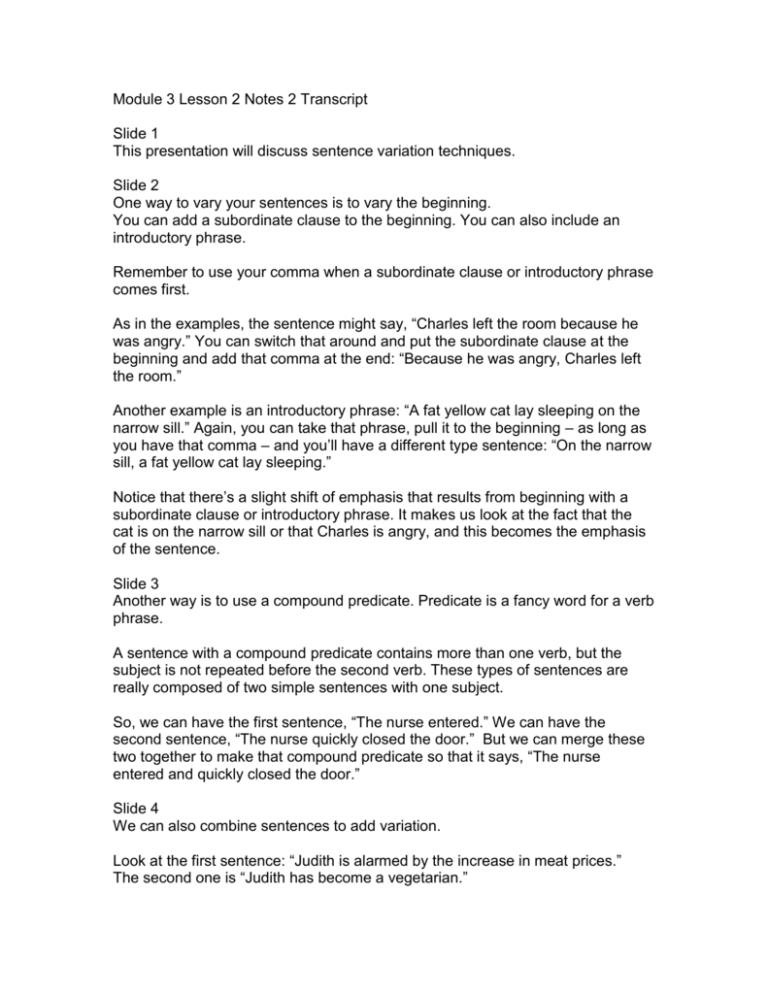
Module 3 Lesson 2 Notes 2 Transcript Slide 1 This presentation will discuss sentence variation techniques. Slide 2 One way to vary your sentences is to vary the beginning. You can add a subordinate clause to the beginning. You can also include an introductory phrase. Remember to use your comma when a subordinate clause or introductory phrase comes first. As in the examples, the sentence might say, “Charles left the room because he was angry.” You can switch that around and put the subordinate clause at the beginning and add that comma at the end: “Because he was angry, Charles left the room.” Another example is an introductory phrase: “A fat yellow cat lay sleeping on the narrow sill.” Again, you can take that phrase, pull it to the beginning – as long as you have that comma – and you’ll have a different type sentence: “On the narrow sill, a fat yellow cat lay sleeping.” Notice that there’s a slight shift of emphasis that results from beginning with a subordinate clause or introductory phrase. It makes us look at the fact that the cat is on the narrow sill or that Charles is angry, and this becomes the emphasis of the sentence. Slide 3 Another way is to use a compound predicate. Predicate is a fancy word for a verb phrase. A sentence with a compound predicate contains more than one verb, but the subject is not repeated before the second verb. These types of sentences are really composed of two simple sentences with one subject. So, we can have the first sentence, “The nurse entered.” We can have the second sentence, “The nurse quickly closed the door.” But we can merge these two together to make that compound predicate so that it says, “The nurse entered and quickly closed the door.” Slide 4 We can also combine sentences to add variation. Look at the first sentence: “Judith is alarmed by the increase in meat prices.” The second one is “Judith has become a vegetarian.” We can put these together by taking out “Judith” and “is” and by putting it together, we have, “Alarmed by the increase in meat prices, Judith has become a vegetarian.” We can change the first sentence to be an introductory clause by dropping the subject and adding a comma. Because we are talking about Judith being alarmed, her name has to go right after, “Alarmed by the increase in meat prices.” Slide 5 We can also join ideas with an “-ing verb or modifier.” This is achieved by converting the verb with an “-ing” and dropping the subject. So let’s look at some examples: “He peered through the microscope.” “He discovered a squiggly creature.” We can change that first sentence into an “-ing modifier” so that it would say, “Peering through the microscope, he discovered a squiggly creature.” Another example: We drove to Tompkins Road. We were surprised by the number of “for sale” signs. In that first sentence, we can change the “drove” to an “-ing modifier” so it would say, “Driving down Tompkins Road, we were surprised by the number of “for sale” signs. Notice that you can make the -ing verb phrase an introductory phrase like we talked about in the first slide. Slide 6 We can also use an interrupter. One interrupter is called an appositive. This is a great way to add variety to your writing. Carlos is the new wrestling champion. He is a native of Argentina. If you look at the bottom, it says an appositive is a word or group of words that renames a noun or pronoun. We know that Carlos is both a wrestling champion and a native of Argentina. So, we can say, “Carlos, a native of Argentina, is the new wrestling champion.” Or, we can put that appositive at the beginning and it can say, “A native of Argentina, Carlos is the new wrestling champion.” Notice your last note there in pink. An appositive must be placed either directly AFTER the word to which it refers or directly BEFORE it. This way, there is no confusion as to whom the appositive is referring. Slide 7 Another strategy is to use another type of interrupter called a relative clause. Relative Clauses can add sophistication to your writing. A relative clause begins with “who,” “which” or “that,” and describes a noun or pronoun. It can join two simple sentences in a longer, more complex sentence. The first sentence we have here says, “Jack just won a scholarship from the Arts Council.” The second sentence says, “He makes wire sculptures.” We can add a relative clause with the word “who,” “which” or “that” to this sentence. Because Jack is a person, we’re going to use the word, “who.” So, our third sentence says, “Jack, who makes wire sculpture, just won a scholarship from the Arts Council.” “Who makes wire sculpture” is a relative clause and replaces the subject with “who.” “Who” now introduces the subordinate relative clause. Slide 8 One last strategy for sentence variation is to use a rhetorical question remember, we learned about rhetorical questions in Module 2. Rhetorical questions don’t ask a question that is meant to be answered. Instead, they are questions that provoke thought. Using a rhetorical question is usually reserved for making a specific point. It should cause your audience to stop and think about your topic. It may even encourage your audience to agree with what you’re saying. Rhetorical questions are just one more way that you can change the way your sentences are structured to keep your writing interesting and engaging.

